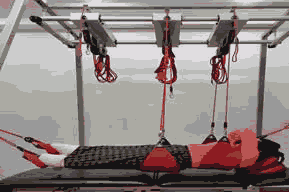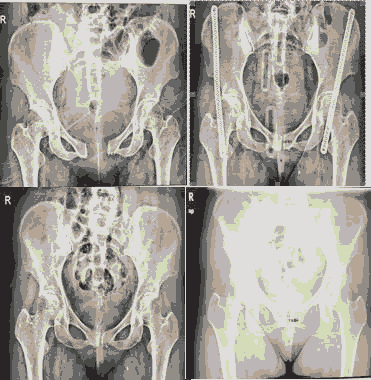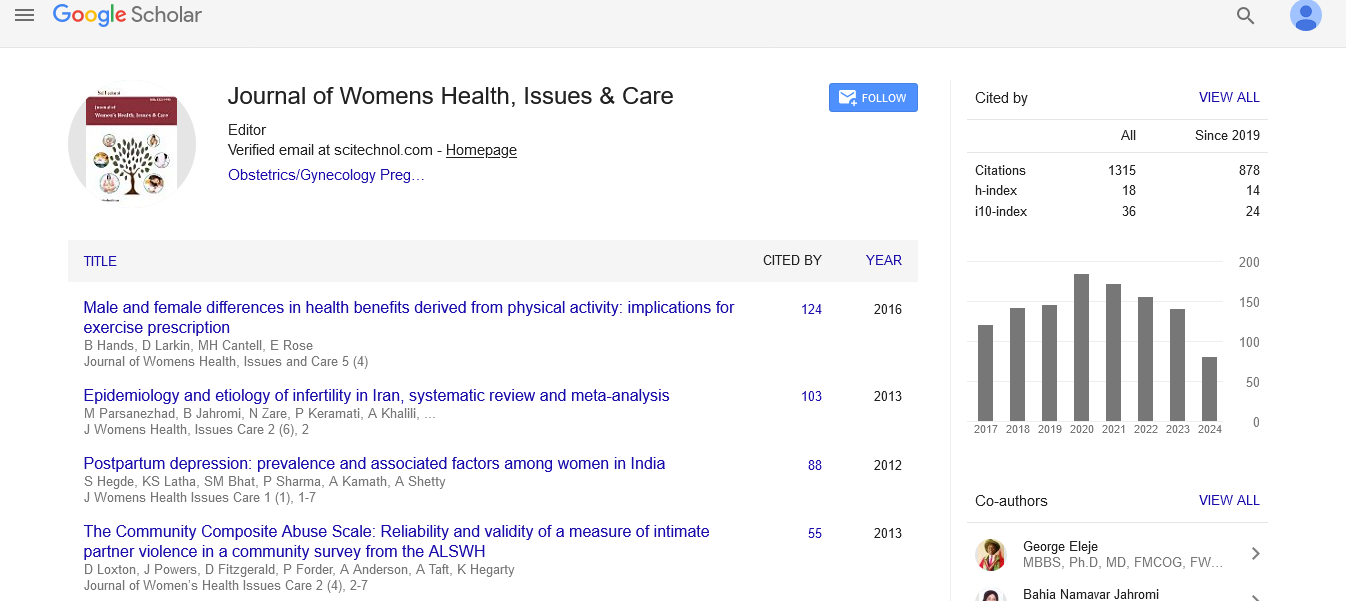Case Report, J Womens Health Issues Care Vol: 11 Issue: 1
Conservative treatment of old separation of pubic symphysis based on the Tissue stress remodeling theory-A case report
Zuncheng Zheng1*, Yan Wang1, Xiaoyu Wang1, Naifeng Kuang1, Yuexia Chen1, Haoyue Chen1, Rui Feng2, Runyuan Yu2, Wenyuan Song3, Zhongxuan Liu3 and Xiaoqian Lv3
1Department of Rehabilitation, Taian City Central Hospital, Taian, Shandong Province, China
2Department of Medicine, Shandong First Medical University and Shandong Academy of Medical Science, Taian, Shandong Province, China
3Department of Medicine, Binzhou Medical University, Binzhou, Shandong Province, China
*Corresponding Author:Zuncheng Zheng
Department of Rehabilitation, Taian City Central Hospital, Taian, Shandong Province, China
E-mail:zxyyzhengzuncheng@126.com
Received date: 31 December, 2021, Manuscript No. JWHIC-21-51044;
Editor assigned date: 03 January, 2022, PreQC No. JWHIC-21-51044 (PQ);
Reviewed date: 17 January, 2022, QC No. JWHIC-21-51044;
Revised date: 22 January, 2022, Manuscript No. JWHIC-21-51044 (R);
Published date: 28 January, 2022, DOI:10.4172/2325-9795.1000376
Citation:Zheng Z, Wang Y, Wang X, Kuang N, Chen Y, et al. (2022) Conservative Treatment of Old Separation of Pubic Symphysis Based on the Tissue Stress Remodeling Theory: A Case Report. J Womens Health 11:2.
Keywords: Old separation of pubic symphysis; Conservative treatment; Suspension; Suspended traction; Sling exercise train
Keywords
Old separation of pubic symphysis; Conservative treatment; Suspension; Suspended traction; Sling exercise tiain
Introduction
Separation of pubic symphysis is considered a complication of vaginal childbirth or pregnancy. A pubic symphysis gap wider than 10 mm combined with clinical symptoms can allow for a diagnosis of perinatal pubic symphysis diastasis [1]. The incidence reported in China and elsewhere has been approximately 1/300 to 1/30000 [2-6]. The incidence is not high, but it seriously affects the psychological and physical health of parturients. At present, there is a lack of understanding of postpartum separation of pubic symphysis, and many patients with separation of pubic symphysis have not been diagnosed and treated in time. This is also the reason for the great difference in regional incidence. There is no gold standard for the treatment of pubic symphysis separation, and reports on the treatment of old pubic symphysis separation are even rarer. Some literatures reported that the separation distance was more than 2.5 cm recommends surgical treatment [7]. A diastasis greater than 14 mm indicates attendant damage to the sacroiliac joint [8]. Changes in the sacroiliac joint can affect the stability of the pelvis and lead to complications such as pain in the pelvic band and abnormal gait. Therefore, timely diagnosis and appropriate treatment are very important. Physi CAL proposed the tissue stress remodeling theory, which combines the histopathology, the law of tension-stress, the viscoelastic theory of tissue, biomechanics and anatomy. On the basis of this theory, the conservative treatment of postpartum pubic symphysis separation with three-dimensional continuous traction+pelvic band fixation+exercise therapy was developed. This method has not only theoretical innovation, but also outstanding clinical effects. The typical pathological reports are as follows.
Case Presentation
A 31-year-old woman came to see her 3 months after delivery because of pain at the pubic symphysis and limited movement. The patient was previously healthy, with no history of metabolic diseases, fractures, scoliosis, or eating disorders. The family history was unremarkable. Her weight gain during her first pregnancy was 17 kg, and a vaginal delivery at 39 weeks and six days with a fetal weight of 3760 g.
Physical examination: Tenderness at the pubic symphysis, VAS pain score 6, showing a swaying gait. Bilateral iliac crest and anterior superior iliac spine are asymmetrical, right low and left high, both lower limbs are unequal in length, and the right lower limb is about 5 mm longer than the left lower limb. The SF-36 quality of life score was 131 points.
Auxiliary examination: 8th August in the year 2020 pelvic X-ray showed that the ilium was high on the left and low on the right, and the pelvis moved slightly to the right. The separation distance of pubic symphysis was about 46.96 mm.
Management and Outcomes
Continuous traction under suspension
Three-dimensional traction was performed under suspension, and the patient took the supine position, and the narrow band of the suspension system Sling Exercise Tiain (SET) was fixed under the armpit and both ankles with an inelastic rope for longitudinal traction. The SET broadband fixed the pelvis with an inelastic rope, and the elastic rope at the pelvis was pulled across to solve the horizontal separation of the pubic symphysis. Adjust the traction direction, angle and strength of both lower limbs according to the three-dimensional information of pubic symphysis joint and sacroiliac joint. To solve the problems of pronation, supination and tilting of unilateral pelvis, adjust the sacroiliac joint and bilateral hip joint under the action of gravity and traction, and realize the alignment and alignment reduction of pubic symphysis (Figure 1). Based on the tension-stress rule of illizarov theory and the viscoelastic theory of soft tissue, the traction time is not less than 1 hour, twice a day, and the periodic evaluation is carried out every week. August 20 in the year the suspension traction began. After 3 weeks of traction, the left and right sides of the sacroiliac joint were stopped and entered into the next step of treatment.

Figure 1: Continuous traction under suspension.
Reset under suspension
The patient took the supine position and placed his hands in front of the chest. The SET narrow band was placed at the ankle joint and under the armpit, the wide band was placed at the pelvis with inelastic rope, and the fixed pelvic belt was placed on the inside of the wide band. The pelvis of the patient was removed from the 30 cm of the suspended bed with SET, and the 30 minutes was suspended. The narrow band fixed in both ankles and armpits was pulled longitudinally for 20 s, while both ankles were rotated at an angle of 45°, and finally the pelvic band was fixed.
After three-dimensional reduction, the X-ray film showed that the reduction was successful if the pubic symphysis and sacroiliac joint were positioned and the alignment was good.
Re-examination and exercise training after reduction
After reduction and fixation of pelvic band, the outpatient clinic was reexamined every 2 weeks.
Review content: 1. Clinical physical examination, including whether there was tenderness at the pubic symphysis, whether the pelvic separation and compression test were positive, and whether the external marks of the pelvis were symmetrical. 2. The distance between pubic symphysis was monitored by color ultrasound, and the healing of fibrous connective tissue at pubic symphysis was observed by color ultrasound. 3. If the distance and alignment between the pubic symphysis are abnormal, the pelvis should be adjusted in time, and if there is no problem in the re-examination, guide the patients to exercise to promote healing. Instructing patients to exercise ankle pump to prevent disturbance of blood circulation. Guide abdominal breathing exercise training, side bridge exercise training, medial thigh muscle adduction training, pelvic rotation training to strengthen core muscle strength and peripelvic muscle strength. After the pelvic band was fixed for 2 months, the X-ray of the pelvis suggests that the distance between the pubic symphysis is 5.70 mm November 20 in the year 2020 and color ultrasound examination of pubic symphysis showed that the distance between pubic symphysis was less than 1 cm, and showed moderate and high echo, and there was no obvious anechoic area. After the pelvic band was removed, the pelvic stabilizer strength training and core strength training were strengthened to stabilize the pelvis.
Outcome and follow-up
•Evaluation of pubic symphysis spacing by positive pelvic radiographyï¼?96 mm was separated from the pubic symphysis before treatment, and the distance between the pubic symphysis was about 5.65 mm after reduction. The distance between the pubic symphysis was 5.70 mm when the pelvic band was removed. 2 months after the pelvic band was removed, the distance between the pubic symphysis was 7.25 mm (Figure 2).
•The Visual Analogue Scale (VAS) pain score was 6 before treatment, 2 when the pelvic band was removed, and 1 at follow-up 2 months after the removal of the pelvic band.
•SF-36 quality of life scale score: The specific scores are shown in Table 1.
Table 1: Quality of life scale score.

Figure 2: Symphysis spacing by positive pelvic radiography.
Discussion and conclusion
The treatment of pubic symphysis separation is mainly divided into conservative treatment and surgical treatment. Conservative treatment is the first choice when the pubic symphysis separation is less than 2.5 cm, the anterior sacroiliac ligament and the sacrospinous ligament are intact, and the pelvic rotation is stable and there are no complications. Mens et al. [9] believed that the satisfaction rate of conservative treatment could reach 67%. For patients with postpartum pubic symphysis separation, active conservative treatment can often achieve good results, and surgical treatment can be performed when conservative treatment fails. When the horizontal separation of symphysis pubis exceeds 2.5 cm, the sacrospinous ligament or the anterior ligament of the sacroiliac joint will fracture, the pelvis will be unstable in rotation, and the integrity of the pelvic ring will be destroyed. In this case, the conservative effect is poor, and surgical treatment is required [10]. However, there are also case reports that the separation distance of pubic symphysis over 4 cm was shortened to 1 cm after conservative treatment, and the clinical symptoms could completely disappear 6 months later [11]. In conclusion, the unsatisfactory results of conservative treatment for patients with horizontal separation of symphysis pubis over 2.5 cm May be related to the lack of systematic conservative treatment based on histopathology.
The case reported in this paper is to solve the anatomical abnormality of sacroiliac joint by applying the tissue stress remodeling theory. The tissue stress remodeling theory believes that continuous stress stimulation can cause structural changes and functional improvement of human tissues. Using different forms of force to give personalized treatment to patients can achieve the purpose of tissue and function remodeling. According to the theory of tissue stress remodeling, the treatment of pubic symphysis separation after postpartum should be divided into four steps, that is, improving symptoms, adjusting structure, stabilizing structure and remodeling function. Symptom relief as the first step in treatment is due to the needs of patients, according to the different symptoms of patients can be given symptomatic treatment. Structural adjustment is the core of tissue stress remodeling therapy system. The system adopts chronic continuous traction for structural adjustment. Due to the viscoelasticity of tissues, the soft tissues around joints undergo a process of creep, plasticization and deformation under a small load and a long time of stress loading. In this process, in addition to the relaxation of tissues under the pull of force, tissues are regenerated under the action of tension-stress, namely the tension-stress rule and tissue regeneration rule [12,13].
Although the old separation of the pubic symphysis is an old dislocation, the anatomy of this joint is special [14]. The symphysis pubis is an amphiarthrosis formed by hyaline cartilage on both sides. Ligaments attached above, below, in front and behind the joint maintain the joint state. Such structural characteristics make the joint dislocation rarely have connective tissue hyperplasia. B ultrasound and MRI both confirmed the low signal at the pubic symphysis of patients with old pubic symphysis separation, proving that there is rarely granulomatous hyperplasia between the joints. This is the anatomic reason for the feasibility of conservative reduction of old pubic symphysis separation. Compared with the acute stage of pubic symphysis separation, the patients with old pubic symphysis separation did not have the condition of immediate restoration. The patients with old pubic symphysis separation were often accompanied by shortening, tearing and adhesion of ligaments, fascia and muscles as well as relative displacement of ilium and sacrum. According to the viscoelasticity theory of tissues, the elasticity of tissues makes them have the tendency to restore deformation. Therefore, the abnormal structure and morphology of these soft tissues and joints make it difficult to fix the reduced joints in the correct position. Therefore, these structural abnormalities should be recovered before joint reduction. When biological tissue is slowly pulled, a certain tension can stimulate tissue regeneration and active growth. It grows like fetal tissue by dividing cells. Human skeleton, like epithelial tissue and connective tissue, has great regenerative potential and plasticity. Give the bone a proper stress pull, and the bone and the muscles, fascia, blood vessels, and nerves attached to it grow in sync. Through continuous traction, stress relaxation, creep and regeneration of abnormal soft tissue were induced, and the normal anatomical position was gradually restored. At this point, the correct mechanical pull is easier to reset.
The pubic symphysis is part of the pelvic ring. Structurally, the pelvic ring consists of two hip bones and a sacrum joined by powerful ligaments to form a self-locking ring, its center through the sacroiliac joint and the symphysis pubis motor center. Functionally, the pelvic ring is a ring axis that transmits motion and load between the lumbosacral-sacroiliac-hip-ischial tuberosity-pubic symphysis. When a woman gives birth, the pelvic ring expands and the range of motion increases, facilitating the delivery of the baby. In addition to its own structural stability factors, pubic symphysis stability also depends on the stability of the sacroiliac joint. So the reduction of the old separation of the pubic symphysis is not just the reduction of the pubic symphysis but the reduction of the entire pelvic ring, a three-dimensional reconstruction, which is the reduction of the auricular surface of the sacroiliac joint by means of upper and lower, left and right, and oblique upward forces.
As mentioned above, according to the viscoelasticity theory of tissues, tissues have a tendency to recover deformation [15]. Therefore, the sacroiliac joint is reduced under suspension and fixed mechanically and anatomically for 6-8 weeks by a special pelvic band after reduction. At this time, the soft tissue is in a healing state, and the reduced joint will not be re-misplaced due to soft tissue elasticity. In this study, no symphysis pubis separation was observed after pelvic girding was removed. It can be seen that chronic continuous traction, three-dimensional reconstruction reduction and continuous pelvic band fixation are feasible for the treatment of the separation of the old symphysis pubis, and the clinical effect is satisfactory.
After three-dimensional reconstruction and fixation of the old symphysis pubis, the sacroiliac joint and the symphysis pubis can restore the normal para-position and line-to-line relationship, which is conducive to correct stimulation of joint proprioceptors, muscle spindle of muscles and tendons, golgi body and other proprioceptors, and effective recovery of proprioception. Proprioception plays a decisive role in pelvic motion control and postural stability. Therefore, the exercise therapy adopted by the research group started after the reduction and fixation of the sacroiliac joint and pubic symphysis, which produced better results in the stability training of the pelvis. The exercise therapy treatment under suspension for 4-6 weeks can achieve the stability of the pelvis and remove the pelvic belt.
Eoretical basis and clinical practice proved that the conservative treatment method of separation of the symphysis pubis adopted in this study, continuous traction under suspension+three-dimensional reconstruction+pelvic restraint fixation+exercise therapy, has strong theoretical feasibility, accurate clinical efficacy and effective improvement of patients' quality of life. This systematic conservative treatment method is worthy of promotion.
Acknowledgement
Thanks to the funding of Taiwan science and technology development plan foundation (2020NS118).
References
- Shnaekel KL, Magann EF, Ahmadi S (2015) Pubic symphysis rupture and separation during pregnancy. Obstet Gynecol Surv 70: 713-718. [Crossref], [Google Scholar], [Indexed].
- Kane R, Erez S, O'leary JA (1967) Symptomatic symphyseal separation in pregnancy. Surg Gynecol Obstet 124: 1032-1036. [Crossref], [Google Scholar], [Indexed].
- Kubitz RL, Goodlin RC (1986) Symptomatic separation of the pubic symphysis. South Med J 79: 578-580. [Crossref], [Google Scholar], [Indexed].
- Saeed F, Trathen K, Want A, Kucheria R, Kalla S (2015) Pubic symphysis diastasis after an uncomplicated vaginal delivery: A case report 35: 746-747. [Crossref], [Google Scholar].
- Ku SJ, Kim SB, Kim JH, Park HY, Kim HJ (2006) Clinical analysis of the perinatal pubic bone separation. Korean J Obstet Gynaecol 49: 315-321. [Crossref],[Google Scholar].
- Heath T, Gherman RB (1999) Symphyseal separation, sacroiliac joint dislocation and transient lateral femoral cutaneous neuropathy associated with McRoberts' maneuver. A case report. J Reprod Med 44: 902-904. [Crossref], [Google Scholar], [Indexed].
- Parker JM, Bhattacharjee M (2009) Peripartum diastasis of the symphysis pubis. N Engl J Med 361: 1886-1887. [Crossref], [Google Scholar].
- Bahlmann F, Merz E, Macchiella D, Weber G (1993) Ultrasound imaging of the symphysis fissure for evaluating damage to the symphysis in pregnancy and postpartum. Z Geburtshilfe Perinatol 197: 27-30. [Crossref], [Google Scholar], [Indexed].
- Mens JM, Huis YH, Pool-Goudzwaard A (2012) The Active Straight Leg Raise test in lumbopelvic pain during pregnancy. Man Ther 17: 364-368. [Crossref], [Google Scholar], [Indexed].
- Mu WD, Hong W, Zhou DS, Yu LZ, Jia HT, et al. (2009) Computer navigated percutaneous screw fixation for traumatic pubic symphysis diastasis of unstable pelvic ring injuries. Chin Med J 122: 1699-1703. [Crossref], [Google Scholar], [Indexed].
- Chang D, Markman BS (2002) Spontaneous resolution of a pubic-symphysis diastasis. N Engl J Med 346: 38-39. [Crossref], [Google Scholar], [Indexed].
- Ilizarov GA (1989) The tension-stress effect on the genesis and growth of tissues. Part I. The influence of stability of fixation and soft-tissue preservation. Clin Orthop Relat Res 238: 249-281. [Crossref], [Google Scholar], [Indexed]
- Ilizarov GA (1989) The tension-stress effect on the genesis and growth of tissues: Part II. the influence of the rate and frequency of distraction. Clin Orthop Relat Res: 263-285. [Crossref], [Google Scholar], [Indexed].
- Becker I, Woodley SJ, Stringer MD (2010) The adult human pubic symphysis: A systematic review. J Anat 217: 475-487. [Crossref], [Google Scholar],[Indexed].
- Proske U, Gandevia SC (2012) The proprioceptive senses: their roles in signaling body shape, body position and movement, and muscle force. Physiol Rev 92: 1651-1697. [Crossref],[Google Scholar],[Indexed].
 Spanish
Spanish  Chinese
Chinese  Russian
Russian  German
German  French
French  Japanese
Japanese  Portuguese
Portuguese  Hindi
Hindi 



